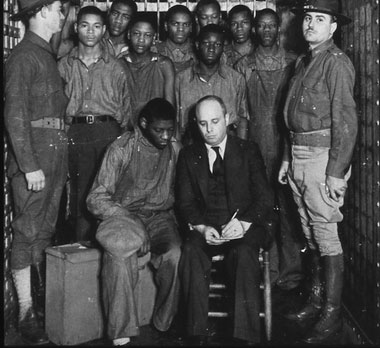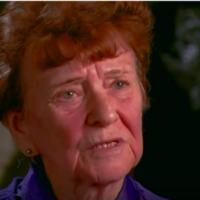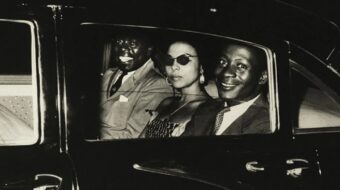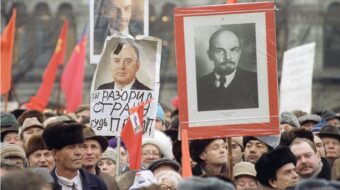
Editor’s note: This week a bipartisan group of Alabama state lawmakers introduced a bill to exonerate the victims of a racist frame-up known as the Scottsboro case. This is a welcome development, although it comes more than 80 years too late.
In 1931, nine young African American men, riding a train in search of work, were attacked by an armed mob and eventually arrested on trumped up rape charges of two white women, who were also on the train in search of jobs. Black and white unemployed and civil rights activists of the time immediately went to work to defend these young men and build a campaign for their freedom. Many of the leading activists and supporters of this historic campaign to free the “Scottsboro Boys” were members of the Communist Party. In fact, this case is so closely linked to the work of the Communist Party and its approach to multi-racial working class unity and struggle that numerous books and articles have been written about it.
The New York Times, some 16 years ago, published an article that (surprise, surprise) grossly distorted the party’s role in the Scottsboro case. To mark both the introduction of this Alabama bill, and as part of Black History Month 2013, peoplesworld.org republishes two articles from our Feb. 15, 1997 edition that challenge a long-forgotten op-ed, and set the record straight on the role of Communists in the Scottsboro case, which- as this week has shown – will never be forgotten. From a first-hand account, key organizer Mary Licht wrote about her role and experience in spearheading the campaign for the Scottsboro Nine’s freedom. Licht was in the PBS American Experience documentary “Scottsboro: An American Tragedy.” Licht was a lifelong member of the CPUSA and the chair of its history commission until her death.
Read Tim Wheeler’s “NY Times: Turning truth on its head-The Scottsboro case.”
– Teresa Albano
On March 25, 1931, an armed mob stopped a freight train at Paint Rock, Ala. and rounded up nine African American youths, the youngest of whom was 13. Two young white women and one white man were also taken off the train. (“Hoboing” or hitching rides on freight trains, the original pretext for stopping the train, was illegal.)
Sheriff’s deputies arrested the nine young men, loaded them onto a flatbed truck and took them to the Jackson County jail in Scottsboro. There they were charged with a second offense: “having raped the white girls in a freight car passing through Alabama.”
When a crowd gathered at the jail, the sheriff called the governor who, in turn, called out the National Guard and the mob dispersed. Twelve days later, all were put on trial and in four days, four separate all-white, all-male juries convicted eight and sentenced them to death.
In the years since, many people have asked how I become involved in the case – an involvement that makes it possible for me to categorically deny Denton L. Watson’s crude lies about the role of the Communist Party in building the campaign to defend the Nine (see editor’s note here).
Yes, we did embarrass the Klan, white supremacists and Alabama authorities. And yes, we plucked a few tail feathers from Jim Crow. But our first – and only – goal was to save the lives of nine innocent young African American youth. I’m proud to say that we accomplished that task and that I had a role in it.
I lived in Chattanooga, Tenn. at that time, as did four of the nine. I first heard of the case while I was in jail awaiting trial for “sedition.”
I considered the arrest of the Scottsboro “boys” and my arrest as two sides of the same coin: They were riding the rails in search of work and I was working to organize the unemployed who had been thrown out of work.
For me, the arrest, trial and conviction of these unemployed Black youth was a symbol of the inequality of the then 12 million African Americans in America. I believed their trial was a legal lynching – that they had been framed and sentenced to death under the pretext of “rape.”
During the Hoover administration of the early 1930s, America found itself in the midst of a devastating economic depression, with millions out of work. Although things were hard in the North, they were desperate in the South where the Depression had really begun in 1927.
But by 1931 a mass fightback had begun. Throughout the country Unemployed Councils, led by the Trade Union Unity League and the Communist Party, were organizing.
Petitions with more than a million signatures demanding relief and unemployment insurance had been presented to the White House in December 1930. I was a leader of the Unemployed Council in Chattanooga.
The councils called mass demonstrations across the country for March 6 to demand that Congress pass the Lundeen Bill for relief, unemployment insurance and Social Security.
Our demonstration in Chattanooga was attended by many Black and white workers but even before the rally started, the three scheduled speakers – I was one of them – were arrested. We were indicted for sedition and held without bail while awaiting trial. Nothing like this happened anywhere else in the country – but it gives one a taste of the South at that time.
When I read about the conviction of the Scottsboro youth, I told my co-worker that when we were released I would secure the International Labor Defense (ILD) for this case. I said the way the ILD had conducted our trial convinced me that it was the only organization that would mobilize the kind of campaign that would overturn the savage death sentences given these youngsters.
Our lawyers didn’t just depend on arguing the fine points of the law or on the “impartiality” of the courts. They said we had to pack the courtroom with our supporters and appeal to the public for support. And they were right.
Our trial was held in a courtroom packed with Black and white unemployed workers and we were freed after a three-day trial, thanks in part to the eloquence of Joe Brodsky, the ILD lawyer who helped us defeat the city’s sedition charge.
A half hour after my release I was visiting Sherman Bell, who was affectionately called the “Mayor” of Chattanooga’s Black community. He had been a delegate to the convention of the American Negro Labor Congress (ANLC) in St. Louis that issued a “Bill of Negro Rights” with the aim of developing a movement to enact legislation for African American rights and to suppress lynching. The ANLC changed their name at this convention to the League of Struggle for Negro Rights and became active participants in the Scottsboro case.
Bell and I visited Mrs. Wright and Mrs. Patterson, mothers of three of the Scottsboro defendants. We told them about how our trial had been conducted – a packed courtroom and a team of eloquent lawyers who believed in our program of equality for African American people.
We explained that the case of the Scottsboro Nine was not a case that could be won in a southern court room. We said that a mass protest movement capable of rallying millions of people from around the world was required if there was to be a stay of the execution scheduled for July 10. We said that without that stay, nothing else mattered.
Wright and Patterson told us that they had been visited by representatives of the NAACP that morning who would, most likely, return. And they did. But, after 10 days of visits and discussion with these two mothers, we secured their agreement that the ILD would represent their sons. Shortly after, the other parents agreed to representation by the ILD.
Immediately after the trial and sentencing, the ILD went to court, demanding a stay of execution and a new trial, since the defendants had not had counsel of their choice during their trial. The rest is history. Demonstrations were organized in major cities across the country and American embassies became the target of angry demonstrators abroad as millions supported the ILD demand.
The militant defense of the Scottsboro Nine became a catalyst that helped bring union organization to thousands of Southern workers. Sharecroppers in Alabama and Arkansas joined the Sharecroppers Union, while workers employed by Tennessee Coal and Iron and miners in Harlan County, Ky. joined unions and laid the base for the CIO that loomed just over the horizon.
The Scottsboro defense by the Communist Party and the International Labor Defense was not a bolt from the blue. Nor was it a liberal humanitarian gesture limited to the plight of nine unemployed Black youth. To the contrary. The decision to represent and fight for the Scottsboro Nine was preceded by years of activity led by the Communist Party and its predecessor organizations.
The founding convention of the Workers Party in 1921 adopted a program of Black equality, at that time a more advanced program than that of any organization. At its 1922 convention, the Party adopted a program for economic, political and social equality that was carried out side-by-side with a struggle against the racism that had oppressed African Americans for centuries.
In the 1924 presidential election campaign, William Z. Foster, the presidential candidate of the Workers Party (which later became the Communist Party), took this program to many cities of the South and in 1928 the Communist Party launched a campaign to organize unorganized southern workers in the textile and steel industries.
Photo: ILD-retained attorney Samuel Leibowitz meets with the Scottsboro defendants under guard by the state militia in 1932. (CC)












Comments